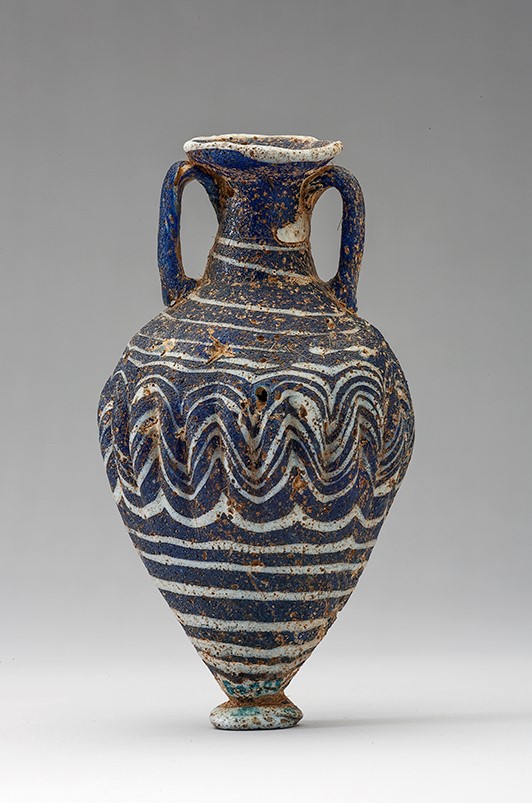Acquisition number: 1971.07
The vase is intact but for a chip from the lip; the surface is worn and pitted and has lost any translucency. There is a hole in the lower wall and two others in the shoulder through faults in manufacture. The handles run from below the rim to the top of the shoulder. The glass is translucent cobalt blue with a line of opaque pale blue at the rim and at the edge of the button base. There is a fine opaque light blue trail, wound from neck to base, marvered zigzags below deeply-combed high rounded shoulder.
Title: Core-formed Amphoriskos - 1971.07
Acquisition number: 1971.07
Author or editor: J.R. Green
Culture or period: Greek Classical.
Date: c. 6th - 5th century BC.
Material: Glass
Object type: Vessels - Amphoriskos
Dimensions: 57mm (w) × 105mm (h)
Origin region or location: Greece
Origin city: Rhodes.
Display case or on loan: 9
Keywords: Greek, Classical, Rhodian
Folio Fine Art Ltd (London), Catalogue 82 (July 1971) no. 236 (ill.); J.R. Green with B. Rawson, Catalogue of Antiquities in the Australian National University, A.N.U. (Canberra, 1981) 112.
1971.07
Core-formed Amphoriskos
Purchased. Ht 10.5cm; diam. 5.7cm.
The vase is intact but for a chip from the lip; the surface is worn and pitted and has lost any translucency. There is a hole in the lower wall and two others in the shoulder through faults in manufacture. The handles run from below the rim to the top of the shoulder. The glass is translucent cobalt blue with a line of opaque pale blue at the rim and at the edge of the button base. There is a fine opaque light blue trail, wound from neck to base, marvered zigzags below deeply-combed high rounded shoulder.
Vessels like this were manufactured by winding and fusing glass about a core; thus the insertion of the pale blue stripes here which could then be given a zigzag effect by drawing a rod across them, much as swirling in modern enamelling.
Yellow was often substituted for or combined with the pale blue. The ribbed effect was achieved by pressing a rod against the wall of the vessel while the glass was still malleable.
Glass of this type is often taken to be Rhodian, and it was certainly a major centre of manufacture. There is a number of standard shapes based on larger pottery vessels such as the amphora, the hydria and the oinochoe, and in general terms the glass series seem to follow these prototypes in the development of shape. On present evidence glass of this category was produced from the sixth to the fifth century BC.
Our piece belongs to Harden’s Eastern Mediterranean Group I (D.B. Harden, Catalogue of Greek and Roman Glass in the British Museum, i [London 1981], 58-59; see also D. Barag, Catalogue of Western Asiatic Glass in the British Museum, I [London 1985] 81, no. 85) and Grose’s Amphoriskos Form 1:3 (see very similar example in D. Grose, The Toledo Museum of Art. Early Ancient Glass (New York 1989, 146-7, no. 106), dating later 6th to 5th century BC. Barag suggests that this type of handle is more likely to be 6th than 5th century BC. Two of the same form but with variant trails were published from a well-dated late 6th century tomb at Ialysos, and Rhodes was certainly a production centre (P. Triantafyllidis, “Early Core-Formed Glass from a Tomb at Ialysos, Rhodes”, Journal of Glass Studies 51, 2009, 26-392: 31, 36 and 87). Grose, however, noted more than one workshop in terms of treatment of the marvering, handles, etc. in the Toledo collection. The slightly splayed neck to rounded shoulders is characteristic of vessels from late 6th century tombs on Rhodes (Triantafyllidis, “Classical and Hellenistic Glass Workshops from Rhodes”, in: D. Foy, M.-D. Nenna (eds), Actes du Colloque de l’ AFAV Echanges et Commerce du Verre dans le Monde Antique, Aix-en-Provence et Marseille, 7-9 Juin 2001 [Monographies Instrumentum 24, Montagnac 2003] 131-138: 131, fig.1), although MacClellan (84 nos 13-14) attributed two of identical profile but very different decoration to the first quarter of the 5th century BC (M.C. MacClellan, Glass Vessels in Ancient Greece,Athens 1992). The latter dating was partly based on an intact amphoriskos from Grave C8 at the Lechaion, Corinth (Eliot, Hesperia 37.4, 1969, 345-367: no. 9 pl. 103) which, because of a lack of pottery within it, was only broadly dated late 6th to early 5th century on the basis of nearby graves. Nevertheless, amphoriskoi attributed to the 5th century generally have different profiles and variant trails.
Folio Fine Art Ltd (London), Catalogue 82 (July 1971) no. 236 (ill.); J.R. Green with B. Rawson, Catalogue of Antiquities in the Australian National University, A.N.U. (Canberra, 1981) 112.
